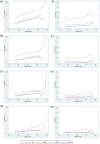The effect of maternal age and planned place of birth on intrapartum outcomes in healthy women with straightforward pregnancies: secondary analysis of the Birthplace national prospective cohort study
- PMID: 24441052
- PMCID: PMC3902355
- DOI: 10.1136/bmjopen-2013-004026
The effect of maternal age and planned place of birth on intrapartum outcomes in healthy women with straightforward pregnancies: secondary analysis of the Birthplace national prospective cohort study
Abstract
Objectives: To describe the relationship between maternal age and intrapartum outcomes in 'low-risk' women; and to evaluate whether the relationship between maternal age and intrapartum interventions and adverse outcomes differs by planned place of birth.
Design: Prospective cohort study.
Setting: Obstetric units (OUs), midwifery units and planned home births in England.
Participants: 63 371 women aged over 16 without known medical or obstetric risk factors, with singleton pregnancies, planning vaginal birth.
Methods: Log Poisson regression was used to evaluate the association between maternal age, modelled as a continuous and categorical variable, and risk of intrapartum interventions and adverse maternal and perinatal outcomes.
Main outcome measures: Intrapartum caesarean section, instrumental delivery, syntocinon augmentation and a composite measure of maternal interventions/adverse outcomes requiring obstetric care encompassing augmentation, instrumental delivery, intrapartum caesarean section, general anaesthesia, blood transfusion, third-degree/fourth-degree tear, maternal admission; adverse perinatal outcome (encompassing neonatal unit admission or perinatal death).
Results: Interventions and adverse maternal outcomes requiring obstetric care generally increased with age, particularly in nulliparous women. For nulliparous women aged 16-40, the risk of experiencing an intervention or adverse outcome requiring obstetric care increased more steeply with age in planned non-OU births than in planned OU births (adjusted RR 1.21 per 5-year increase in age, 95% CI 1.18 to 1.25 vs adjusted RR 1.12, 95% CI 1.10 to 1.15) but absolute risks were lower in planned non-OU births at all ages. The risk of neonatal unit admission or perinatal death was significantly raised in nulliparous women aged 40+ relative to women aged 25-29 (adjusted RR 2.29, 95% CI 1.28 to 4.09).
Conclusions: At all ages, 'low-risk' women who plan birth in a non-OU setting tend to experience lower intervention rates than comparable women who plan birth in an OU. Younger nulliparous women appear to benefit more from this reduction than older nulliparous women.
Keywords: Intrapartum Care; Midwifery Led Care; Obstetrics.
Figures


References
-
- Office for National Statistics. Live births in England and Wales by characteristics of mother 1, 2011. November 2013. http://www.ons.gov.uk/ons/dcp171778_296157.pdf.
-
- Martin JA, Hamilton BE, Ventura SJ, et al. Births: final data for 2009. Natl Vital Stat Rep 2011;60:1–70 - PubMed
-
- Biro MA, Davey M-A, Carolan M, et al. Advanced maternal age and obstetric morbidity for women giving birth in Victoria, Australia: a population-based study. Aust N Z J Obstet Gynaecol 2012;52:229–34 - PubMed
-
- Carolan M. Maternal age ≥45 years and maternal and perinatal outcomes: a review of the evidence. Midwifery 2013;29:479–89 - PubMed
-
- Delbaere I, Verstraelen H, Goetgeluk S, et al. Pregnancy outcome in primiparae of advanced maternal age. Eur J Obstetr Gynecol Reprod Biol 2007;135:41–6 - PubMed
Publication types
MeSH terms
Grants and funding
LinkOut - more resources
Full Text Sources
Other Literature Sources
Medical
